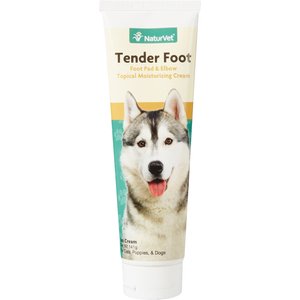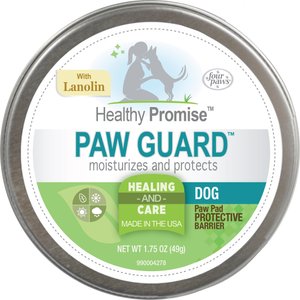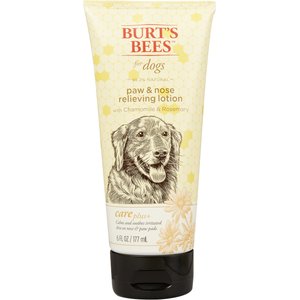Playing fetch-the-snowball, romping through fluffy drifts and taking quiet walks during snowfalls are just some of the reasons why winter can be a wonderland of fun for you and your dog. But these activities can also wreak havoc on dog paws. “While pet pads are a lot more resilient than our feet, they do have their limits,” said Dr. Graham Brayshaw, DVM and director of animal services at the Animal Humane Society in Minnesota. Chemical de-icers, salt and ice can cause painful injuries to dog paws. If left untreated, it can lead to infections and severe pain, requiring medications or even surgery, according to Dr. Brayshaw. “Exposure to enough heat, or cold or rough surfaces can irritate, inflame or wear through any pad.” That doesn’t mean that your dog has to be left out in the cold when it comes to wintertime fun. Keep her little dog paws safe and healthy with these simple pet care tips.
Give Them Sure Footing
Before you head out to enjoy winter games, make sure your dog’s paws are in good shape. Check pet paws for cracks, cuts or other issues. Use moisturizing topical treatments like Angels’ Eyes Soft Paw Moisturizer, that’s made with natural ingredients for rough, dry and cracked pet paws. You can help insulate them from the cold with natural creams like Tomlyn Protecta-Pad Paw Pad and Elbow Cream.
Waterproof booties can help keep dog feet warm and safe, but not all dogs are comfortable wearing anything on their feet. They may try to chew them off or refuse to walk at all. To help your pup get used to the idea of wearing dog booties, don’t wait until the day the big snow storm hits. “Practice putting them on and taking them off your pet for a few weeks so they’ll be used to them when a snow day comes,” said Steven Appelbaum, president and CEO of Animal Behavior College in Santa Clarita, CA.
Use Gentler De-Icers for Pet Paws
Chemical de-icers and sidewalk salt used on streets and sidewalks can not only irritate and burn pet paws, but they can also make your dog sick. When dissolved in water, the chemicals in de-icers react; it creates heat to melt the ice that potentially burn your dog’s paws. These chemicals can also stick to your dog’s feet in the form of ice balls. When licked, they can cause mouth burns, diarrhea and other health problems.
“If your pet becomes reluctant to walk shortly after outdoor exposure, is excessively licking or biting at their toes, or you notice redness on the skin around the paw pads, this may indicate a problem with chemical exposure on their feet,” says Dr. Lee Gregory, DVM at the Maine Medical Center. “In these cases, remove any ice balls, wash or wipe your dog’s feet clean, and contact your veterinarian in case additional treatment is needed.”
Keep Ice Melters Pet-Safe
Start your winter day on the right foot by avoiding areas known to use de-icers. If you’re not sure, look for the tell-tale white pellets or salt rocks. At your own residence, use pet-safe, salt-free ice melters. Sand is another alternative, and while it’s safer than salt, it can cause chafing. On those occasions when avoiding de-icers isn’t possible, use topical treatments like Four Paws Paw Guard with Lanolin. This product is specially made to protect paws against salt, sand and other ice and snow eliminators.
Along with de-icers, walking on sharp ice edges or stepping on pointy objects buried in the snow can also cause damage to dog feet. Be sure to check pet paws for any burns, cuts or other injuries, and consult your veterinarian if needed. Protect and repair paw pads with soothing treatments like NaturVet Tender Foot, Food Pad & Elbow Cream. And if Jack Frost’s been nipping at your dog’s nose, you can use a natural moisturizer made just for cracked noses, like Burt’s Bees Care Plus+Paw & Nose Relieving Lotion that’s made with chamomile and rosemary flower extract.
Nip Frostbite in the Pet Paws
In most cases, frostbite is a result of being exposed to the cold for long periods of time. The best way to avoid it is to stay indoors during extreme winter weather, says Dr. Brayshaw. But in those instances when it can occur, watch for the following the signs:
- Trouble moving extremities like feet, tail and ear tips
- Discoloration of the skin
- Burns or direct damage to tissue
If you suspect your pet has frostbite, consult your veterinarian as soon as possible.
Other Winter Safety Tips for Dogs
- Consider your dog’s breed when going out in winter weather. “Huskies and many other breeds are made for running in the snow, but a Chihuahua needs a jacket when it starts to get chilly,” advises Dr. Brayshaw.
- Tread on ice lightly, because slips and falls—particularly for elderly pets—are more common in winter.
- Do not leave your pet outside in extreme temperatures.
- Keep antifreeze away from pets. It’s poisonous and can be deadly if ingested.
- Move food and water indoors to keep them from freezing over.
Use this guide to help keep pet paws safe from snow, ice, de-icers and other cold-weather dangers so you can enjoy plenty of fun snow days with your pup.

Chris Brownlow has been writing about pets for over 10 years. As a writer who believes in immersing herself in her topic, she has tasted more than 20 different flavors of dog and cat food while working on an advertising campaign for PetSmart. Prior to her pet days, Chris was a print and digital journalist at The Tampa Tribune and The Virginian-Pilot.
Share:















